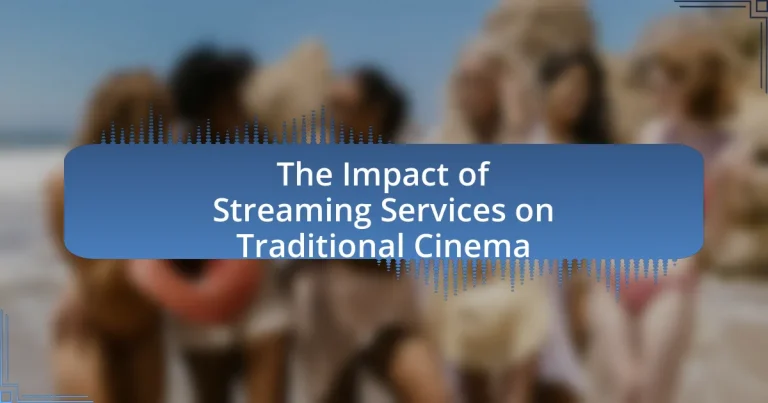The article examines the significant impact of streaming services on traditional cinema, highlighting changes in viewing habits, revenue models, and film distribution. It discusses how platforms like Netflix and Amazon Prime have led to a decline in box office attendance and altered audience preferences towards on-demand content. Key differences between streaming and traditional cinema experiences are outlined, including accessibility and social interaction. The article also addresses the challenges faced by cinemas, such as decreased revenue and competition, while exploring opportunities for adaptation and innovation in the evolving landscape of film consumption. Additionally, it analyzes the implications of streaming on film production, diversity, and audience engagement.

What is the Impact of Streaming Services on Traditional Cinema?
Streaming services significantly impact traditional cinema by altering viewing habits and revenue models. The rise of platforms like Netflix and Amazon Prime has led to a decline in box office attendance, with a 2020 report indicating that U.S. cinema attendance dropped by 80% during the pandemic, highlighting a shift towards home viewing. Additionally, streaming services have changed the distribution landscape, allowing films to bypass traditional theatrical releases, as seen with Warner Bros. releasing its entire 2021 film slate simultaneously in theaters and on HBO Max. This shift challenges traditional cinema’s dominance and forces theaters to adapt to new consumer preferences and competition from digital platforms.
How have streaming services changed the way audiences consume films?
Streaming services have fundamentally transformed audience film consumption by providing on-demand access to a vast library of films anytime and anywhere. This shift has led to a decline in traditional cinema attendance; for instance, in 2020, U.S. box office revenues dropped by 80% due to the pandemic and the rise of streaming platforms like Netflix and Disney+. Audiences now prefer the convenience of watching films from home, often leading to binge-watching behaviors, which contrasts sharply with the scheduled viewing of films in theaters. Additionally, streaming services have democratized access to diverse content, allowing niche films to reach wider audiences that may not have been viable in traditional cinema settings.
What are the key differences between streaming and traditional cinema experiences?
Streaming and traditional cinema experiences differ primarily in accessibility, viewing environment, and social interaction. Streaming services allow viewers to watch content anytime and anywhere, while traditional cinema requires attendance at a specific location and time. The viewing environment in streaming is often more casual, with viewers able to pause or rewatch scenes, whereas traditional cinema offers a communal experience with a large screen and surround sound, enhancing immersion. Social interaction also varies; streaming can be a solitary experience or shared through virtual means, while traditional cinema fosters in-person engagement among audiences. These differences highlight the evolving landscape of film consumption as streaming continues to reshape audience habits.
How do streaming services influence viewing habits and preferences?
Streaming services significantly influence viewing habits and preferences by providing on-demand access to a vast library of content, which encourages binge-watching and personalized viewing experiences. Research indicates that 70% of viewers prefer binge-watching series, a behavior largely facilitated by platforms like Netflix, which releases entire seasons at once. Additionally, algorithms used by these services analyze user behavior to recommend content tailored to individual tastes, further shaping viewing choices. This shift towards personalized content consumption has led to a decline in traditional television viewership, with a 2021 Nielsen report showing that streaming accounted for 28% of total TV viewing time, surpassing cable for the first time.
What challenges do traditional cinemas face due to streaming services?
Traditional cinemas face significant challenges due to the rise of streaming services, primarily including decreased audience attendance and revenue loss. As streaming platforms like Netflix and Amazon Prime Video offer convenient access to a vast library of films from home, many consumers opt for this alternative over the traditional cinema experience. According to a 2021 report by the Motion Picture Association, global box office revenues dropped by 72% in 2020 due to the pandemic and the surge in streaming, highlighting the financial strain on cinemas. Additionally, streaming services often release films simultaneously in theaters and online, further diminishing the exclusivity that cinemas once provided. This shift in viewing habits has led to a decline in ticket sales, forcing many traditional cinemas to adapt their business models or face closure.
How has revenue generation been affected for traditional cinemas?
Revenue generation for traditional cinemas has significantly declined due to the rise of streaming services. In 2020, the global box office revenue fell by approximately 71% compared to 2019, largely attributed to the COVID-19 pandemic and the increasing popularity of platforms like Netflix and Disney+. These streaming services offer consumers convenient access to a vast library of films from home, leading to reduced theater attendance and lower ticket sales. As a result, traditional cinemas have faced financial challenges, with many reporting substantial losses and some even closing permanently.
What role does competition play in the survival of traditional cinema?
Competition plays a crucial role in the survival of traditional cinema by driving innovation and improving the overall cinematic experience. As streaming services like Netflix and Amazon Prime offer diverse content and convenience, traditional cinemas must adapt by enhancing their offerings, such as providing premium viewing experiences, exclusive screenings, and improved customer service. For instance, the introduction of luxury seating and gourmet concessions in theaters has been a direct response to the competitive pressure from streaming platforms. This adaptation is essential for traditional cinemas to attract audiences who might otherwise choose to watch films at home.
What opportunities arise for traditional cinema in the age of streaming?
Traditional cinema can leverage streaming by enhancing audience engagement through exclusive content and events. Streaming platforms provide traditional cinemas with opportunities to host special screenings, premieres, and interactive experiences that attract viewers seeking unique experiences. For instance, films like “Tenet” and “Dune” have utilized hybrid release strategies, where cinemas benefit from increased foot traffic during limited theatrical runs before streaming availability. Additionally, partnerships with streaming services can lead to co-productions, allowing traditional cinemas to showcase films that may not have received theatrical releases otherwise, thus broadening their film offerings and attracting diverse audiences.
How can traditional cinemas adapt to the streaming landscape?
Traditional cinemas can adapt to the streaming landscape by enhancing the in-theater experience and offering exclusive content. By providing amenities such as luxury seating, gourmet food options, and immersive technologies like IMAX or 4D, cinemas can attract audiences seeking a unique outing that streaming cannot replicate. Additionally, partnering with streaming services to showcase exclusive premieres or special screenings can draw viewers who are interested in content that is not available on their home platforms. For instance, the success of films like “The Irishman,” which was released in theaters before streaming on Netflix, illustrates how traditional cinemas can benefit from collaboration with streaming services.
What innovative strategies are being employed by cinemas to attract audiences?
Cinemas are employing innovative strategies such as enhanced viewing experiences, exclusive content, and community engagement initiatives to attract audiences. Enhanced viewing experiences include the adoption of advanced technologies like IMAX and 4D, which provide immersive environments that cannot be replicated at home. Exclusive content strategies involve offering early screenings, special events, and unique film festivals that feature independent films or director Q&As, creating a sense of urgency and exclusivity. Community engagement initiatives, such as themed movie nights and partnerships with local businesses, foster a sense of belonging and encourage audience participation. These strategies are essential as they address the competition posed by streaming services, which have significantly changed consumer viewing habits.

How do streaming services impact film production and distribution?
Streaming services significantly alter film production and distribution by prioritizing direct-to-consumer models and enabling diverse content creation. These platforms, such as Netflix and Amazon Prime, invest heavily in original content, which has led to an increase in production budgets and the emergence of new filmmakers. For instance, Netflix’s spending reached approximately $17 billion on content in 2020, illustrating its commitment to producing a wide array of films. Additionally, streaming services facilitate global distribution, allowing films to reach international audiences without traditional theatrical releases. This shift has resulted in a decline in box office revenues for theaters, as consumers increasingly prefer the convenience of streaming. According to a report by the Motion Picture Association, the number of streaming subscribers surpassed 1 billion globally in 2020, highlighting the growing influence of these services on film consumption patterns.
What changes have occurred in film production due to streaming platforms?
Streaming platforms have significantly altered film production by prioritizing content quantity and diversity over traditional theatrical releases. This shift has led to increased investment in original content, with platforms like Netflix and Amazon Prime Video spending billions annually on film production, resulting in a broader range of genres and storytelling styles. Additionally, streaming services have enabled filmmakers to bypass traditional studio systems, allowing for more independent and niche projects to reach audiences. According to a 2021 report by PwC, the global streaming market is projected to grow to $70 billion by 2024, reflecting the substantial impact these platforms have on production dynamics and audience engagement.
How do streaming services influence the types of films being produced?
Streaming services significantly influence the types of films being produced by prioritizing diverse content that appeals to global audiences. These platforms, such as Netflix and Amazon Prime, invest heavily in original programming, leading to an increase in niche genres and unconventional storytelling that may not have been viable in traditional cinema. For instance, Netflix’s commitment to producing over 70 original films in 2021 alone demonstrates its strategy to cater to varied tastes and demographics, which encourages filmmakers to explore innovative concepts and formats. This shift has resulted in a broader representation of cultures and voices in film, as streaming services actively seek out international content to attract subscribers worldwide.
What is the impact of streaming on independent filmmakers?
Streaming has significantly democratized access for independent filmmakers, allowing them to reach wider audiences without the traditional barriers of theatrical distribution. This shift has enabled filmmakers to showcase their work on platforms like Netflix, Amazon Prime, and Hulu, which collectively accounted for over 50% of the U.S. streaming market share in 2022. As a result, independent films can gain visibility and financial support through subscription-based models, which often prioritize diverse content. Furthermore, a report by the Independent Film & Television Alliance indicates that streaming services have increased the production of independent films, with a 30% rise in titles produced in the last five years. This trend highlights the positive impact of streaming on the independent film sector, fostering creativity and innovation while providing filmmakers with new revenue streams.
How has film distribution evolved with the rise of streaming services?
Film distribution has evolved significantly with the rise of streaming services, shifting from traditional theatrical releases to digital platforms. Streaming services like Netflix, Amazon Prime Video, and Disney+ have enabled films to reach audiences directly at home, often bypassing the conventional cinema model. This change is evidenced by the fact that in 2020, during the COVID-19 pandemic, many major studios opted for simultaneous releases on streaming platforms and in theaters, a strategy that was previously uncommon. Additionally, streaming services have increased the volume of content available, with Netflix alone releasing over 70 original films in 2021, demonstrating a shift towards a more consumer-driven distribution model.
What are the new distribution models emerging from streaming services?
New distribution models emerging from streaming services include direct-to-consumer releases, subscription-based access, and ad-supported streaming. Direct-to-consumer releases allow content creators to bypass traditional theatrical distribution, as seen with films like “Trolls World Tour,” which was released directly on platforms like Universal’s own streaming service. Subscription-based access, exemplified by services like Netflix and Disney+, provides users with unlimited access to a library of content for a monthly fee, fundamentally changing how audiences consume media. Ad-supported streaming models, such as those implemented by platforms like Hulu and Peacock, offer free access to content while generating revenue through advertisements, catering to a broader audience. These models reflect a significant shift in the distribution landscape, emphasizing flexibility and accessibility for viewers.
How do streaming platforms affect the traditional release windows for films?
Streaming platforms significantly shorten traditional release windows for films by offering simultaneous or near-simultaneous releases online. This shift allows audiences to access new films from home, reducing the exclusivity and duration of theatrical runs. For instance, during the COVID-19 pandemic, major studios like Warner Bros. released films simultaneously in theaters and on HBO Max, leading to a reevaluation of release strategies. According to a 2021 report by the Motion Picture Association, 80% of surveyed consumers preferred the option to watch films at home, indicating a strong demand for this model. This trend challenges the conventional 90-day theatrical window, prompting studios to adapt their distribution strategies to remain competitive.

What cultural shifts are associated with the rise of streaming services?
The rise of streaming services has led to significant cultural shifts, including changes in viewing habits, content consumption, and social interactions. Audiences now prefer binge-watching entire seasons of shows, which contrasts with the traditional model of weekly episode releases. This shift is evidenced by a 2021 survey indicating that 70% of viewers binge-watch series, highlighting a preference for on-demand content. Additionally, streaming platforms have democratized access to diverse content, allowing for a broader representation of voices and stories, which has been shown to increase cultural awareness and acceptance. Furthermore, the communal aspect of viewing has evolved, with social media platforms facilitating discussions and interactions around content, thereby transforming how audiences engage with media.
How do streaming services influence film diversity and representation?
Streaming services significantly enhance film diversity and representation by providing platforms for underrepresented voices and stories. These services, such as Netflix and Amazon Prime, invest in original content that reflects a wide range of cultures, identities, and experiences, which traditional studios often overlook. For instance, Netflix’s commitment to diverse storytelling is evident in its production of films like “Roma,” which highlights Mexican culture, and “The Half of It,” which centers on LGBTQ+ themes. According to a 2021 report by the USC Annenberg Inclusion Initiative, streaming platforms have increased the representation of women and people of color in lead roles compared to traditional film studios. This shift not only broadens the narrative landscape but also encourages a more inclusive industry, ultimately influencing audience expectations and demands for diverse content.
What impact do streaming platforms have on global cinema exposure?
Streaming platforms significantly enhance global cinema exposure by providing access to a diverse range of films from various countries and cultures. These platforms, such as Netflix and Amazon Prime Video, have expanded their libraries to include international titles, allowing audiences worldwide to discover films that may not have received theatrical distribution in their regions. For instance, Netflix reported that in 2020, over 80% of its subscribers watched content from outside their home countries, demonstrating the platforms’ role in breaking geographical barriers. Additionally, streaming services often invest in original content from different nations, further promoting global cinema and increasing visibility for filmmakers who might otherwise struggle to reach international audiences.
How do streaming services contribute to the democratization of film access?
Streaming services contribute to the democratization of film access by providing a vast library of films to a global audience at an affordable price. These platforms, such as Netflix and Amazon Prime Video, allow users to access diverse content from various genres and countries without the limitations of geographical distribution or traditional cinema schedules. For instance, as of 2023, Netflix boasts over 230 million subscribers worldwide, illustrating its extensive reach and ability to make films accessible to a broad demographic. This accessibility enables independent filmmakers to showcase their work alongside major studio productions, fostering a more inclusive film landscape.
What are the implications of streaming services on audience engagement?
Streaming services significantly enhance audience engagement by providing on-demand access to a vast array of content, which caters to diverse viewer preferences. This accessibility allows audiences to consume media at their convenience, leading to increased viewing frequency and longer watch times. For instance, a report by Nielsen indicates that streaming accounted for over 30% of total TV viewing time in the United States as of 2021, demonstrating a shift in how audiences engage with content. Additionally, the interactive features of many streaming platforms, such as personalized recommendations and social sharing options, further foster deeper connections between viewers and the content, enhancing overall engagement levels.
How do streaming services foster community and discussion among viewers?
Streaming services foster community and discussion among viewers by providing interactive features such as comment sections, watch parties, and social media integration. These platforms enable users to engage in real-time conversations about content, share opinions, and create a sense of belonging through shared viewing experiences. For instance, Netflix introduced a feature allowing users to host virtual watch parties, which enhances communal viewing and discussion. Additionally, platforms like Twitch and Discord facilitate live chats and forums where viewers can discuss shows and movies, further strengthening community ties. Research indicates that 70% of viewers prefer to watch content with others, highlighting the importance of these interactive features in fostering community.
What role do social media and streaming platforms play in audience interaction?
Social media and streaming platforms significantly enhance audience interaction by facilitating real-time communication and engagement. These platforms allow viewers to share opinions, reactions, and content related to films and shows, creating a community around shared interests. For instance, a study by the Pew Research Center found that 69% of adults in the U.S. use social media, which serves as a space for discussions and fan interactions, thereby increasing viewer investment in the content. Additionally, streaming services often integrate social features, such as watch parties and comment sections, which further promote audience participation and feedback. This dynamic interaction not only enriches the viewing experience but also influences content creation, as producers can gauge audience preferences and trends through social media analytics.
What best practices can traditional cinemas adopt to thrive alongside streaming services?
Traditional cinemas can thrive alongside streaming services by enhancing the in-theater experience through unique offerings and community engagement. By providing exclusive screenings, special events, and immersive experiences such as themed nights or interactive screenings, cinemas can attract audiences seeking more than what streaming offers. For instance, a study by the National Association of Theatre Owners indicates that cinemas that host events like Q&A sessions with filmmakers or live performances see increased attendance and customer loyalty. Additionally, implementing loyalty programs and partnerships with local businesses can create a sense of community and encourage repeat visits. These strategies leverage the unique advantages of physical cinema spaces, making them appealing alternatives to home viewing.


